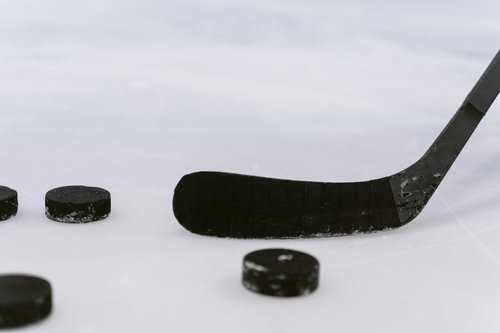Hockey players tape their sticks for better grip and control. Taping also helps protect the stick and puck handling.
In hockey, small details can make a big difference. Taping a stick is one such detail that players swear by. The tape provides a secure grip, which is essential when moving at high speeds. It also helps players control the puck better, making passes and shots more precise.
Taping can protect the stick from wear and tear, extending its life. Each player has their own way of taping, creating a unique feel. This simple act of taping is a tradition that ties together skill, comfort, and durability in the fast-paced world of hockey.

Credit: howieshockeytape.com
History Of Stick Taping
The tradition of taping hockey sticks has a rich history. This practice not only enhances performance but also provides a glimpse into the evolution of the sport.
Early Traditions
In the early days of hockey, players used simple materials. They wrapped their sticks with cloth or friction tape. This helped with grip and control. It also protected the stick from damage. The main goal was to improve handling and extend the stick’s life.
Evolution Over Time
Over the years, stick taping evolved. Modern players use specialized hockey tape. This tape is designed for durability and better performance. Today, there are various types of tapes for different needs.
Players now use white or black tape. Some prefer white for visibility, while others choose black for its sleek look. Taping techniques have also changed. Each player has a unique style that suits their play.
Here is a comparison of early taping methods and modern techniques:
| Early Taping | Modern Taping |
|---|---|
| Cloth or friction tape | Specialized hockey tape |
| Basic wrapping for grip | Custom patterns for better control |
| Simple and practical | Enhanced performance and style |
Overall, the history of stick taping shows the sport’s growth. From simple cloth wraps to advanced techniques, taping remains crucial for hockey players.
Benefits Of Taping
Hockey players often tape their sticks for various reasons. Taping offers several benefits that can enhance a player’s performance. Two of the most significant benefits are improved grip and enhanced control. These benefits can make a noticeable difference during a game.
Improved Grip
Taping a hockey stick provides better grip. The tape adds texture to the stick’s surface. This helps players hold onto their sticks more securely. A better grip reduces the chance of the stick slipping during play. This is crucial during fast-paced games where every move matters. The right grip can improve a player’s confidence on the ice.
Enhanced Control
Taping the stick also enhances control. The tape allows for better puck handling. Players can feel the puck more precisely. This is important for making accurate passes and shots. Enhanced control can give players an edge over their opponents. It allows for smoother movements and more precise plays. The added control can be a game-changer in crucial moments.
Types Of Tape Used
Hockey players often tape their sticks for better control and performance. Different types of tape serve various purposes. In this section, we will explore two popular types of tape used by hockey players: cloth tape and friction tape.
Cloth Tape
Cloth tape is the most common type used by hockey players. It provides a good grip on the stick. This tape is easy to tear and apply. Players can wrap it around the blade, handle, or shaft. It helps in puck control and stickhandling. Cloth tape comes in various colors and widths. Some players use it to show team spirit.
Friction Tape
Friction tape is another popular choice. It is sticky on both sides. This tape offers excellent grip. It is thicker than cloth tape. Players use it mainly on the blade of the stick. Friction tape helps in better puck control. It also adds extra weight to the blade. This can improve shooting accuracy. Friction tape usually comes in black color. It is less common but highly effective.
Taping Techniques
Hockey players tape their sticks to improve their game. Taping provides better grip, control, and protection. There are various methods to tape a hockey stick. Understanding these methods can enhance a player’s performance.
Heel To Toe Method
The Heel to Toe Method is popular among many hockey players. This method starts at the heel of the blade. It moves toward the toe, covering the entire blade. Here is how to do it:
- Start at the heel of the blade.
- Wrap the tape tightly around the blade.
- Continue wrapping until you reach the toe.
- Make sure the tape overlaps slightly.
- Press down to ensure no air bubbles.
This method gives a consistent feel for the puck. It also protects the blade from wear and tear.
Toe To Heel Method
The Toe to Heel Method is less common but effective. This method starts at the toe of the blade. It moves toward the heel, covering the entire blade. Here is how to do it:
- Start at the toe of the blade.
- Wrap the tape tightly around the blade.
- Continue wrapping until you reach the heel.
- Make sure the tape overlaps slightly.
- Press down to ensure no air bubbles.
This method is preferred by players who handle the puck with the toe. It provides a different feel and grip compared to the heel to toe method.
Customization And Personalization
Hockey players often tape their sticks for practical reasons. Customization and personalization are key. Taping allows players to modify their sticks to suit their style. It also helps improve their performance on the ice.
Patterns And Colors
Patterns and colors play a significant role. Many players use different colors of tape. This helps to identify their stick easily. Some prefer solid colors. Others choose stripes or other designs. The choice of pattern is often a way to express individuality. It can also create a psychological advantage.
Player Preferences
Player preferences vary widely. Some players like a thick layer of tape. Others prefer a thin layer. The way the tape is applied also differs. Some wrap it tightly. Others leave it loose. These preferences can affect grip and control. They can also impact the feel of the stick during play. Personalizing the tape can boost a player’s confidence.

Credit: www.gafferpower.com

Credit: kwikrinksyntheticice.com
Frequently Asked Questions
Why Do Hockey Players Tape Their Sticks?
Taping provides better grip, control, and protects the stick. It also helps the puck stick to the blade.
What Tape Do Hockey Players Use?
Players use cloth hockey tape. It’s durable and offers good grip. Some use friction tape for extra stickiness.
How Often Should A Hockey Stick Be Taped?
It depends on usage. Some players retape every game, others every few games. Frequent taping ensures optimal performance.
Does Taping The Stick Affect Performance?
Yes, it improves grip and control. Taping can enhance puck handling and shooting accuracy.
Can Taping Prevent Stick Damage?
Yes, taping the blade reduces wear and tear. It protects against chips and cracks during play.
Do All Hockey Players Tape Their Sticks The Same Way?
No, taping styles vary. Each player has personal preferences for grip and blade coverage.
Is There A Right Way To Tape A Hockey Stick?
No single right way exists. Players experiment to find what works best for them.
Can Beginners Benefit From Taping Their Sticks?
Absolutely. Taping improves grip and control, aiding skill development for new players.
Are There Any Rules About Taping Hockey Sticks?
There are no strict rules, but tape should not interfere with play. NHL has guidelines on tape color for goalies.
Conclusion
Taping hockey sticks offers many benefits for players. It improves grip and control. It also protects the stick from damage. Players can personalize their sticks with tape. This helps them feel more comfortable on the ice. Taping is a simple yet important part of hockey.
It can make a difference in performance. Whether you play for fun or in a league, try taping your stick. You might notice a positive change in your game. So, grab some tape and get ready to hit the ice!




